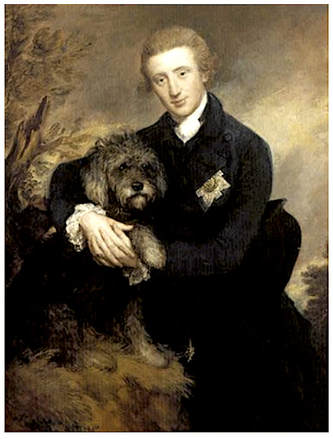|
Joan M. Rehlin
As part of our promotional support of the national Prevention of Cruelty to Animals campaign, our April mini art history post highlights Thomas Gainsborough (5/14/1727–8/2/1788). Considered the primary British portraitist of the second half of the 18th century, Gainsborough is also recognized for his great love of dogs. Gainsborough’s affectionate artistic portrayal of dogs is in keeping with his advocating kindness toward animals, and he is attributed with encouraging people to see dogs as individual, sentient beings. Best known for portraits of people, e.g. “The Blue Boy” (1770), Gainsborough included dogs in many of his human portraits. In addition, he depicted dogs as the only subject in a number of artworks created on commission. And his “Tristram and Fox” painting (c. 1775) is a portrait of his wife’s and his two dogs, who were considered family members. Gainsborough’s father recognized his young son’s talent, and at the age of 13, Gainsborough was permitted to move to London to study art. In 1761, he began exhibiting paintings in what is now the Royal Society of Arts. In 1769, he was a founding member of the Royal Academy of Arts, and was an ongoing exhibitor at the institution which continues today to promote visual works of art through exhibitions and education. Gainsborough, an experimental as well as technically proficient artist, applied paint quickly in a style that combined poetic sensibility with his observations of nature. He preferred to paint landscapes over portraits, but because his portraits were more popular, in the 1770s he began depicting the subject in a landscape setting. The painting shown here is a lesser-known but, nonetheless, our favorite Gainsborough painting, and is hanging in the Duke of Buccleuch’s ancestral home. Henry Douglas-Scott 3rd Duke of Buccleuch, oil painting, c 1760, Thomas Gainsborough
0 Comments
Leave a Reply. |
ART BLOGWelcome to our Art Blog where we occasionally present topics of interest in the fine art world, including featuring artists other than Jim Rehlin. Some of the artwork has been created by long-departed but well-known greats; some, by compelling contemporary artists. All will be pieces we find worthwhile to share with you. If you like any of these, consider sharing the posts forward to your own blogs and other social media. |
|
Artwork by Jim Rehlin.
Website content and modifications ©2024 Rehlin Graphics / Fine Art. All rights reserved. Click HERE to Visit and Like Rehlin Graphics / Fine Art on Facebook. THANKS! |

 RSS Feed
RSS Feed
